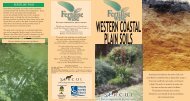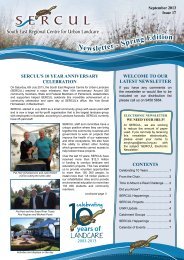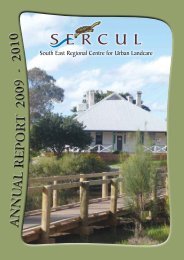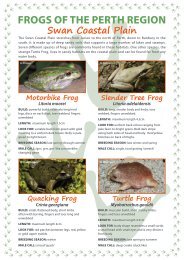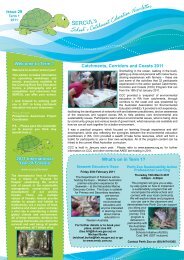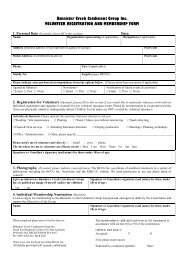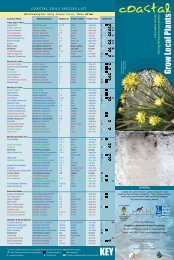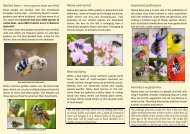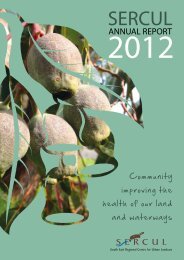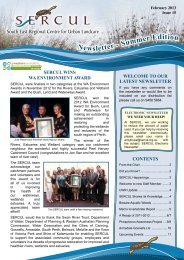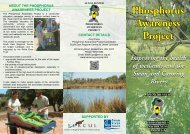Anstey – Keane - SERCUL
Anstey – Keane - SERCUL
Anstey – Keane - SERCUL
Create successful ePaper yourself
Turn your PDF publications into a flip-book with our unique Google optimized e-Paper software.
<strong>Anstey</strong>-<strong>Keane</strong><br />
botanical jewel<br />
by Rod Giblett and<br />
David James<br />
A seemingly unremarkable parcel<br />
of land in Forrestdale harbours a<br />
profusion of flora species if you<br />
know where and how to look.
An area’s biological importance is<br />
not always immediately apparent.<br />
This is certainly the case at <strong>Anstey</strong>-<br />
<strong>Keane</strong> dampland—a small parcel of<br />
uncleared land in the heart of semirural<br />
and semi-urban Forrestdale. This<br />
is not a jarrah forest with its leafy<br />
canopy, nor a karri forest with its<br />
stately giants. Yet this patch of bush<br />
harbours a remarkable diversity of<br />
plant species amid an ever-encroaching<br />
urban environment.<br />
Dampland, heathland and<br />
wetland<br />
Many of the flora species in the<br />
<strong>Anstey</strong>-<strong>Keane</strong> area are found in lower<br />
and wetter land known as ‘dampland’.<br />
Here, moisture is diffused through<br />
the land and not usually visible on<br />
the surface. The wetness of the land<br />
is usually inferred only from the types<br />
<strong>Anstey</strong>-<strong>Keane</strong><br />
dampland<br />
Armadale<br />
of plants it supports. Dampland is<br />
thus unlike other wetlands, such as<br />
the nearby internationally significant<br />
Forrestdale Lake with its large body<br />
of open shallow water in winter and<br />
spring that usually dries out in summer.<br />
Damplands are moist basins covered<br />
with plants. The types of plants found<br />
in damplands depend on moisture<br />
close to the surface of the land. As<br />
many of these plants are short and<br />
ground-hugging, the area is often<br />
called heathland, though there are also<br />
sedgelands and herblands in the area.<br />
Before European settlement, these<br />
once floristically rich damplands<br />
occurred from Pinjarra to the southern<br />
Perth metropolitan area. The sandy,<br />
clay soils of these flat damplands called<br />
the Pinjarra Plain have resulted in the<br />
evolution of their unique vegetation<br />
Previous page<br />
Main <strong>Anstey</strong>-<strong>Keane</strong> dampland.<br />
Inset Green kangaroo paw.<br />
Left Purple flag is common in the reserve.<br />
Below Starflower.<br />
Photos <strong>–</strong> Sallyanne Cousans<br />
over thousands of years. The northernmost<br />
tip of the Pinjarra Plain is<br />
wedged between the Bassendean Dune<br />
complex to the west and the Wungong<br />
River to the east. Confined almost<br />
solely to the east side of the Swan<br />
Coastal Plain, the Pinjarra Plain was<br />
highly suitable as good agricultural<br />
land and so has been almost entirely<br />
cleared. With the removal of almost<br />
all the native vegetation for farming,<br />
the only places it can be found today<br />
are along the Perth<strong>–</strong>Bunbury railway<br />
line, road verges (such as Mundijong<br />
Road), nature reserves, remnants on<br />
private property, and two large areas in<br />
Forrestdale, including the east side of<br />
Forrestdale Lake Nature Reserve and<br />
the <strong>Anstey</strong>-<strong>Keane</strong> damplands.<br />
<strong>Anstey</strong>-<strong>Keane</strong><br />
The <strong>Anstey</strong>-<strong>Keane</strong> dampland is<br />
made up of three parcels of land:<br />
one vested in the Western Australian<br />
Planning Commission and part of<br />
Jandakot Regional Park; another vested<br />
in Landcorp (Western Australian Land<br />
Authority) and not part of the regional<br />
park; and a third parcel of two lots in<br />
private hands. None of this area is vested<br />
in the Conservation Commission of<br />
Western Australia.<br />
From <strong>Anstey</strong> Road, the dampland is<br />
flat and the vegetation is low. It stretches<br />
from Armadale Road in the south to<br />
Ranford Road to the north. The land<br />
is flat with barely a rise or fall. The<br />
trees are short and the bushes and other<br />
vegetation are low. One nearby resident<br />
calls the area “scrub”, implying that its<br />
vegetation is low, ugly and worthless—<br />
fit only for clearing for roads and<br />
housing. Much of its vegetation is small<br />
and exquisite, but intrinsically valuable<br />
in its own right.
Above Native bee on stinkwood.<br />
Photo <strong>–</strong> Ann Storrie<br />
Right Male splendid wren.<br />
Photo <strong>–</strong> Rob Drummond/Lochman<br />
Transparencies<br />
The fact that <strong>Anstey</strong> Road is straight<br />
doesn’t help in people’s appreciation of<br />
it as they drive past. Despite its austere<br />
appearance, this site, known as Bush<br />
Forever Site 342, is the second most<br />
floristically diverse Bush Forever site<br />
on the Swan Coastal Plain. It has 381<br />
species, second to Greater Brixton<br />
Street (Site 387) with 518. Compare<br />
this with the iconic Kings Park (Site<br />
317) in central Perth that has 293<br />
native taxa (plus a whopping 172 weed<br />
taxa). What’s more, the <strong>Anstey</strong>-<strong>Keane</strong><br />
dampland has more than 75 per cent of<br />
its vegetation in an excellent to pristine<br />
condition, while Kings Park has 15 per<br />
cent rated as in excellent condition.<br />
Natural refuge<br />
While unremarkable to the<br />
uninformed observer, the bush here<br />
harbours a kaleidoscope of species,<br />
such as the swamp fox banksia (Banksia<br />
telmatiaea), one-sided bottlebrush<br />
(Calothamnus hirsutus), swamp cypress<br />
(Actinostrobus pyramidalis), sand<br />
bottlebrush (Beaufortia squarrosa),<br />
and Regelia ciliata, which provides<br />
important habitat for the southern-<br />
brown bandicoot, or quenda (Isoodon<br />
obesulus).<br />
Several species of melaleucas are also<br />
found in the dampland, including robin<br />
red breast bush (Melaleuca lateritia) and<br />
saltwater paperbark (Melaleuca cuticularis),<br />
more commonly found closer to the<br />
coast. Lower ground-cover plants are<br />
icons of the area with exceptional<br />
colour in spring. Some highlights<br />
found in the dampland include the<br />
woolly dragon (Pityrodia uncinata)—<br />
the southern-most population of this<br />
species according to the Bush Forever<br />
site description—Petrophile seminuda,<br />
basket flower (Adenanthos obovatus),<br />
swamp pea (Euchilopsis linearis) and<br />
stinkwood (Jacksonia sternbergiana).<br />
Many herbaceous species found<br />
here show themselves each spring.<br />
Many species of orchids occur here<br />
including Purdie’s donkey orchid (Diuris<br />
purdiei), a declared rare flora species,<br />
and many more species of orchids.<br />
Green kangaroo paws (Anigozanthos<br />
viridis) are endemic to the damp areas.<br />
Carpets of pink petticoats (Utricularia<br />
multifida) also appear here, brushing the<br />
landscape with an extra blaze of colour.<br />
Many sundews (Drosera spp.) are also<br />
pink and give an exceptional splash of<br />
colour when in flower.<br />
In spring 2008, acres of red and<br />
green kangaroo paws (Anigozanthos<br />
manglesii) surrounded this low<br />
dampland. Fresh new flowers along the
Tiny white everlastings daisies spread at my feet like little drifts of hailstones.<br />
I look up and see a willie wagtail chasing a goshawk, nipping at its tail. Behind<br />
them, swirls of chiffon clouds are scattered across the sky. As I walk I hear<br />
little clicking insect noises coming from the bushes. A lone wanderer butterfly<br />
floats by and settles on a drumstick-like dasypogon flower. Airborne again, its<br />
exquisite orange and black wings are like stained-glass windows, illuminated<br />
by the morning sun. Everywhere, small spritely blue-grey butterflies flit from<br />
bush to bush; and on a bare patch of ground sit three little orange-legged<br />
grasshoppers. A bright green katiydid, almost invisible, crawls along a matching<br />
green leaf; its presence betrayed only by its movement. In the distance I see<br />
a mass of mauve and, taking care not to tread on the myriad of tiny delicate<br />
flowers that cover the ground, I follow a kangaroo trail towards a profusion of<br />
purple flags. As I walk along, moths, grasshoppers and flies flit up from around<br />
my feet. I hear wrens nearby. I see a bright blue wren and hear it trilling lustily<br />
from the top of a bare twig. He glides to the ground where he joins a modestly<br />
clad female and two more males, just as bright blue as himself. I watch a colony<br />
of stick-nest ants at work. A march fly nips my hand. A dragonfly zooms past.<br />
At my feet is the imprint of a large kangaroo’s foot in the dried-up mud.<br />
Bryony Fremlin is a noted wildlife artist and a resident of Forrestdale.<br />
tall trunks of the balgas (Xanthorrhoea<br />
preissii) were covered in insects feeding<br />
on nectar. Red bugle (Blancoa canescens)<br />
is found in the Landcorp land. This<br />
is an orange<strong>–</strong>red coloured plant now<br />
rare in the Perth metropolitan area and<br />
generally only found to the north.<br />
T H E G O V E R N M E N T O F<br />
W E S T E R N A U S T R A L I A<br />
A walk in nature at <strong>Anstey</strong>-<strong>Keane</strong> by Bryony Fremlin<br />
Department of<br />
Environment and Conservation<br />
Our environment, our future<br />
Two threatened ecological<br />
communities have been described in<br />
the area. They are associated with<br />
seasonal wetlands. One of these is<br />
endangered type 10a, described by<br />
Bush Forever, as ‘shrublands on<br />
dry clay flats’ and the other is<br />
Left background <strong>Anstey</strong>-<strong>Keane</strong> dampland.<br />
Photo <strong>–</strong> Marie Lochman<br />
Below left Black-faced woodswallows.<br />
Photo <strong>–</strong> Sallyanne Cousans<br />
Below right Basket flower.<br />
Photo <strong>–</strong> Jiri Lochman<br />
Bottom Sand bottlebrush and swamp<br />
cypress.<br />
Photo <strong>–</strong> Sallyanne Cousans<br />
vulnerable type 8, ‘herb-rich shrublands<br />
in clay pans’.<br />
Because of its size, this area<br />
supports a rich representation of birds<br />
and mammals including the western<br />
grey kangaroo (Macropus fuliginosus)<br />
or quenda. Several species of bird are<br />
attracted to the flowering heathland<br />
shrubs such as the white-cheeked and<br />
tawny crowned honeyeaters, along with<br />
insectivorous birds such as the splendid<br />
blue wren, white-winged triller, and<br />
black-faced wood swallow. Raptors<br />
include the little eagle, wedge-tailed<br />
eagle and nankeen kestrel.<br />
A protected future?<br />
Given its significance to flora<br />
and fauna in an ever-growing urban<br />
environment, the Friends of Forrestdale<br />
are proposing that the <strong>Anstey</strong>-<strong>Keane</strong><br />
dampland be protected, named<br />
‘Regelia Reserve’ and nominated for<br />
the Directory of Important Wetlands<br />
in Australia. They hope, with such<br />
protection, people for many years to<br />
come will have the opportunity to<br />
learn about the hidden riches of such<br />
biologically important areas.<br />
Rod Giblett is secretary of the Friends<br />
of Forrestdale and is a senior lecturer<br />
in the School of Communications and<br />
Arts at Edith Cowan University. He is<br />
the author of several environmental<br />
books including Forrestdale: People<br />
and place.<br />
David James is president of the<br />
Friends of Forrestdale and a well-<br />
known naturalist. He has lived in<br />
Forrestdale all his life.<br />
© DEC 2009. Reprint from LANDSCOPE Magazine (Winter 2009),<br />
published by the Department of Environment and Conservation.<br />
Executive Editor: Ron Kawalilak. Editor: Samille Mitchell. Designer: Tiffany Taylor.<br />
2009241-0609-500




